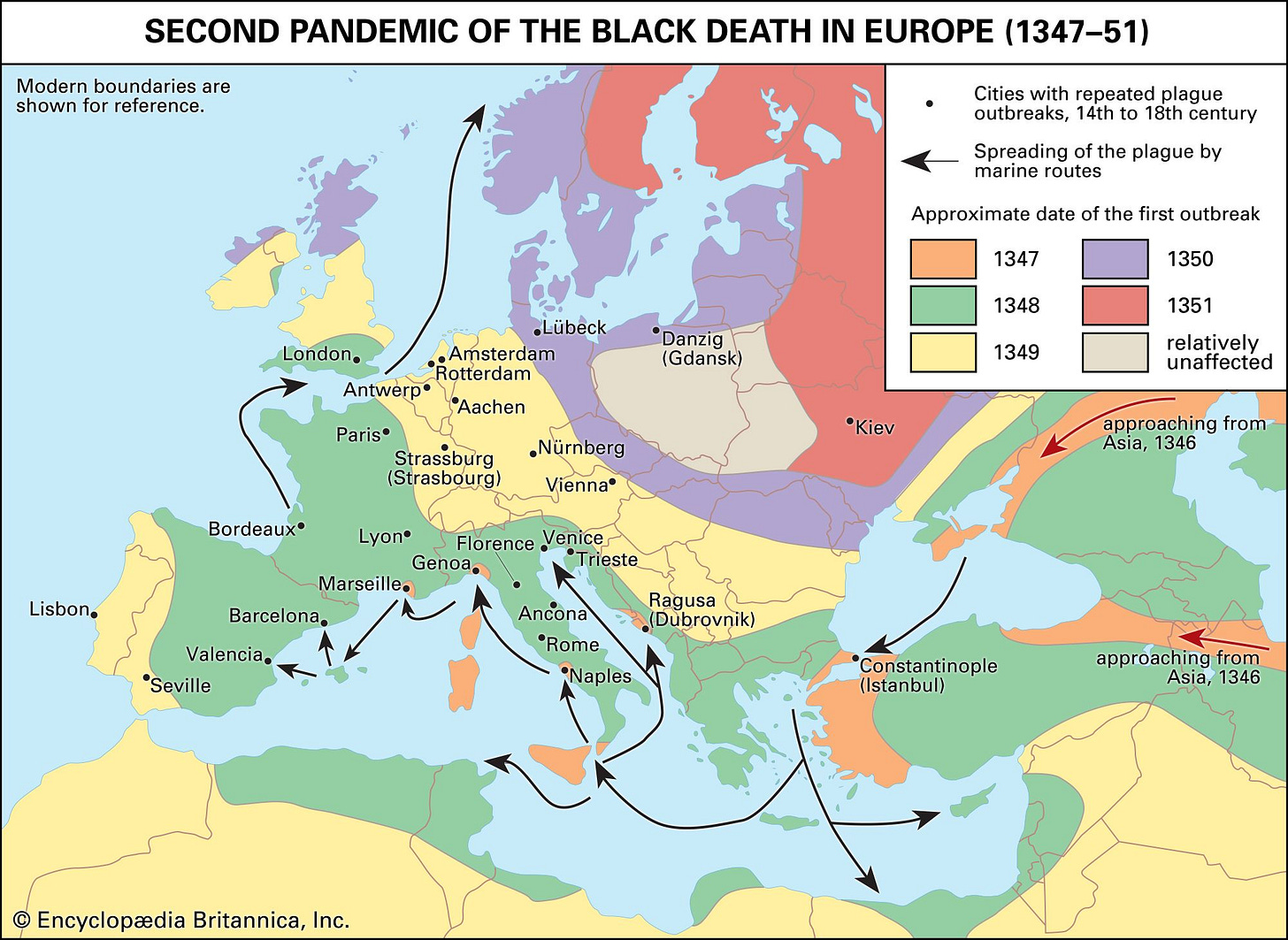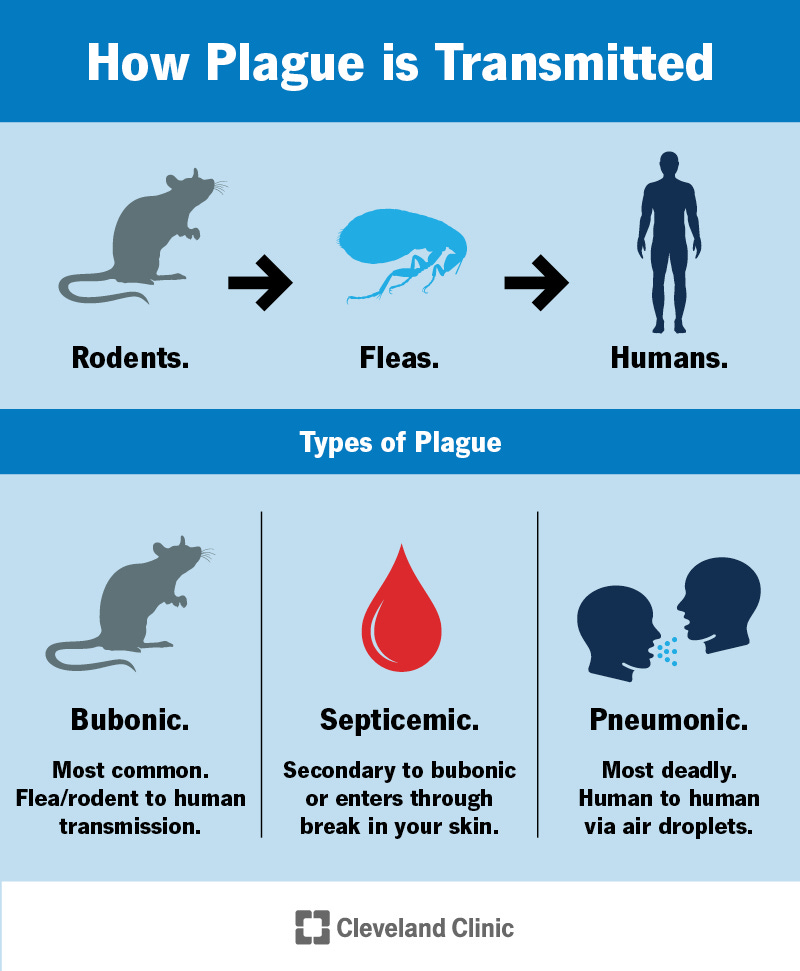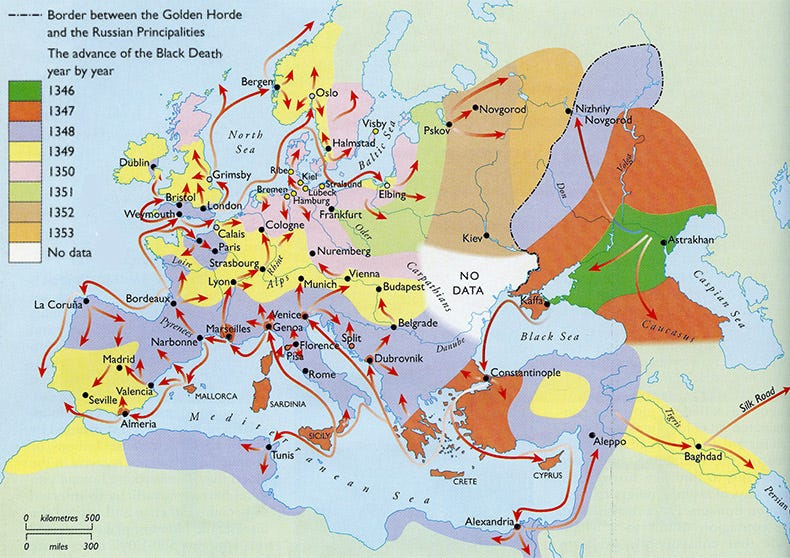The Black Death's Swift Devastation to Medieval Europe
The Bubonic Plague is infamous for its rapid spread throughout Europe in the Middle Ages as well as the sheer amount of deaths brought by it. Sweeping through Europe in the mid-14th century, it decimated populations, altered social structures, and had profound cultural and economic impacts. The plague's rapid spread and high mortality rate caused unparalleled fear and disruption, leaving a lasting imprint on European history.
The plague is caused by the bacterium Yersinia pestis, which is typically transmitted through the bite of an infected flea that has fed on the blood of a rodent, often a rat. Swollen lymph nodes, fever, chills, and prostration characterize the disease. Historical records trace the origins of the Black Death to Central Asia, specifically brought through the Mongol Empire, from where it traveled along the Silk Road, reaching the Crimea by 1347. In late 1346, a devastating plague outbreak occurred among the besiegers and subsequently spread into the town. At this time, the Siege of Caffa was ongoing with Mongolian armies fighting Genoa tradesmen for the strategic port city. Notably, the Mongol forces employed a form of biological warfare by catapulting plague-infested corpses into the city. This incident marks one of the earliest documented cases of such warfare. As spring arrived, Genoese merchants fled the area on ships, unknowingly carrying the Black Death. The plague, initially transmitted by fleas on rats, first affected humans near the Black Sea and then rapidly spread throughout Europe due to mass migrations. Rats accompanied humans during these migrations, traveling among various commodities. Research indicates that black rats, the main transmitters of the disease, primarily favor grain as their source of sustenance. Consequently, the transportation of grain by major fleets from Africa and Alexandria to densely populated areas, coupled with manual unloading processes, played a pivotal role in the increased transmission of the plague.
A map of the Black Death’s spread throughout Europe from 1347-1351. Note how it travels along trade routes such as the Silk Road and important ports like Constantinople, Venice, and Genoa.
The disease had a devastating impact on Europe. It is estimated that approximately 25 million people lost their lives to the Black Death between 1347 and 1351, representing about one-third of the population at the time. Some areas experienced even higher mortality rates, with cities such as Florence and Venice losing up to 60% of their residents.
Biologically, the plague had three forms: bubonic, pneumonic, and septicemic, each more deadly than the last. The bubonic form, characterized by swollen lymph nodes (buboes), had a mortality rate of about 60-70% if untreated. The pneumonic form, which affected the lungs, was even more lethal, with a near 100% mortality rate and the ability to spread through airborne droplets from coughing or sneezing. The septicemic form, which infected the bloodstream, was almost invariably fatal. This multifaceted nature of the disease meant it could spread through multiple vectors, making containment extremely difficult.
An infographic by Cleveland Clinic shows how the plague is spread to humans along with the three types of plague shown below.
The Bubonic Plague bacteria under a microscope.
Environmental factors played a critical role in the plague's spread. The 14th century as a whole was marked by climatic changes, including the Little Ice Age, which brought cooler temperatures and erratic weather patterns. These changes disrupted agriculture, leading to poor harvests, food shortages, and malnutrition, weakening the population's immune systems and making them more susceptible to infection. The widespread famine that preceded the plague's arrival had already left Europe in a vulnerable state, creating a perfect storm for the disease to take hold.
Social and economic conditions further exacerbated the situation. Medieval Europe was characterized by dense population centers with inadequate sanitation and primitive medical knowledge. Cities were overcrowded, with narrow streets filled with waste, and people lived in close quarters with livestock, all of which provided fertile breeding grounds for rats and fleas. Moreover, the lack of understanding of disease transmission meant that effective quarantine measures were rarely implemented, and those often came too late.
Moreover, trade networks facilitated the rapid spread of the plague. Europe’s extensive trade routes, both overland and maritime, enabled the disease to travel quickly from one region to another. Ships, in particular, were notorious carriers of the plague, as rats aboard vessels could easily spread the disease to port cities. The movement of armies and pilgrims further accelerated the transmission, as infected individuals carried the disease to new areas.
A more detailed map showing how the plague spread each year across Europe from the sea and overland.
Lastly, the social response to the plague often made matters worse. As fear and panic spread, people fled infected areas, unknowingly carrying the disease with them. There was also widespread scapegoating and persecution of minority groups, particularly Jews, who were falsely blamed for causing the plague. The widespread fear and panic caused by the plague, which killed millions, intensified these prejudices. Rumors spread that Jews were deliberately poisoning wells and rivers to spread the disease, a notion that found fertile ground in a society already inclined to distrust them. These accusations were bolstered by the fact that Jewish communities were often less affected by the plague, possibly due to their sanitary practices, which were rooted in religious rituals. This social turmoil diverted attention from effective disease control measures and led to further chaos and displacement.
The widespread loss of life brought by the plague resulted in profound and immediate consequences. Families were torn apart, leaving many children orphaned and claiming the lives of a significant number of the elderly who were particularly vulnerable. The breakdown of family structures led to a disintegration of community life, with social bonds strained as a result of fear of contagion. The demographic shift also had notable effects on migration patterns. Survivors often relocated from rural areas to cities in pursuit of improved opportunities, drawn by the higher wages offered due to labor shortages. Conversely, some individuals fled the cities, perceiving them as plague epicenters, seeking refuge in the perceived safety of the countryside. This movement of people not only contributed to the spread of the disease but also led to a redistribution of the population across Europe. It took centuries for Europe's population to recover to its pre-plague levels, as recurring outbreaks of the plague and other diseases continued to claim lives periodically. This extended period of demographic instability had a profound and enduring impact on European society, influencing its development for generations.
The Bubonic Plague had significant economic consequences that impacted all levels of society. The large number of deaths led to a shortage of labor, which in turn brought about a series of economic changes. With fewer workers available, those who survived were able to demand higher wages. This change in the labor market was particularly noticeable in agriculture, where the lack of farm workers resulted in a significant increase in labor costs. Landowners, dealing with higher expenses and lower revenues from their lands, had to rework labor contracts and, at times, offer better terms to keep workers.
The economic changes brought by the large death toll contributed to the decline of the feudal system as labor became more valuable. Serfs and peasants started to exert more control over their lives and work against their lords. Many negotiated for better conditions or moved to towns and cities where they could find higher-paying jobs. This weakening of the economic system that ruled Medieval Europe for centuries set the stage for the emergence of more modern economic and social structures such as mercantilism. Additionally, the plague disrupted trade and industry. Many skilled workers and artisans died, leading to a decline in the production of goods. Trade networks, crucial for the economic well-being of medieval Europe, were severely affected as merchants and traders succumbed to the disease. The decrease in population also meant a reduced market for goods, further hindering economic activity.
Governments across Europe faced the challenge of reduced tax revenues as both the population and economic activity dwindled. With fewer people to tax and a drop in productivity, state coffers shrank. In an attempt to stabilize their economies, some governments implemented policies aimed at controlling inflation and maintaining social order. For instance, the English government passed the Ordinance of Labourers in 1349 and the subsequent Statute of Labourers in 1351, which aimed to cap wages at pre-plague levels and restrict labor mobility. Despite these efforts, inflation was rampant, as the reduced supply of goods could not meet the unchanged or even increased demand, especially for food and essential items. The scarcity of labor also meant that agricultural and industrial production suffered, further exacerbating economic instability.
This economic upheaval forced governments to rethink their fiscal policies. The need to finance ongoing wars, maintain public order, and manage depleted resources led to innovative but often unpopular measures. Taxation systems were overhauled, and new forms of taxes were introduced, sometimes targeting different segments of society more heavily than before. This fiscal pressure, combined with the social strain of the plague's aftermath, occasionally led to social unrest. Notable examples include the Peasants' Revolt in England in 1381, where economic grievances and resentment against poll taxes contributed to widespread rebellion.
In summary, the Black Death's rapid and devastating impact on Europe resulted from a lethal combination of biological virulence, conducive environmental conditions, poor sanitation and medical knowledge, extensive trade networks, and counterproductive social responses. These factors together created a scenario in which the plague could spread unchecked, leading to one of the deadliest pandemics in human history. Additionally, the impact brought by such a devastating disease was heavily consequential, shifting societal and cultural norms in Medieval Europe. With this, not only did the Black Death bring a pandemic that remains unmatched in modern times, but it also brought with it the beginnings of the early modern age and the decline of the Middle Ages.






